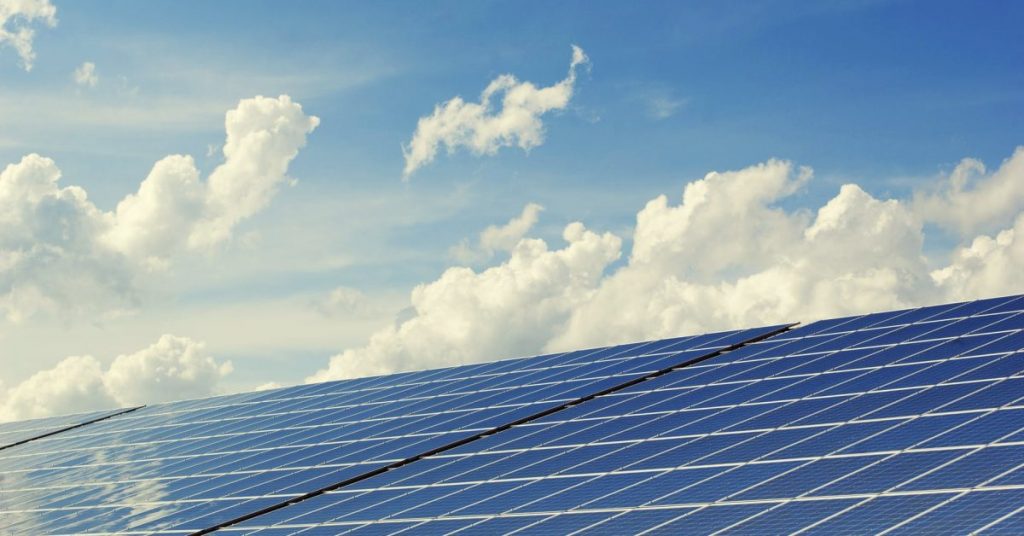Record numbers of solar panels shipped in the US in 2021 – here’s why those numbers will rise
US shipments of solar panels – including imports, exports, and domestically produced and shipped panels – rose to a record electricity-generating capacity of 28.8 million peak kilowatts (kW) in 2021, according to the US Energy Information Administration (EIA). That was up from 21.8 million peak kW in 2020.
In 2021, about 80% of US solar panel module shipments were imports, and they primarily came from Asia.
The EIA notes of its data reporting:
US solar panel shipments closely track domestic solar capacity additions; differences between the two usually result from the lag time between shipment and installation. We categorize solar capacity additions as either utility-scale (facilities with 1 megawatt of capacity or more) or small-scale (largely residential solar installations).
The United States added 13.2 gigawatts (GW) of utility-scale solar capacity in 2021. That was an annual record, and it was 25% more than the 10.6 GW of utility-scale solar added in 2020.
Small-scale solar capacity installations in the United States increased by 5.4 GW in 2021, up 23% from 2020, which saw 4.4 GW added. Residential installations made up more than 3.9 GW of small-scale installations in 2021, compared with 2.9 GW in 2020.
As Electrek reported on August 29, Bloomberg NEF (BNEF) reported that US homeowners are expected to install a record 5.6 GW of residential solar in 2022. BNEF predicts that residential solar will outpace commercial solar every year to 2030.
In 2021, five states accounted for 46% of all US solar panel shipments. The top five states were:
California (5.09 million peak kW)
Texas (4.31 million peak kW)
Florida (1.80 million peak kW)
Georgia (1.15 million peak kW)
Illinois (1.12 million peak kW)
Electrek’s Take
To state the obvious, solar is only going to keep growing in the United States, and there are a number of reasons for this. Electricity costs and fossil fuel prices are surging, and they’re not expected to drop. Contrast this with the declining cost of solar panels, which dropped 11% from 2020 to 2021. And that’s despite project delays and supply chain problems and things like the US Department of Commerce investigation into solar manufacturing in Southeast Asia.
When homeowners buy a solar plus battery storage system, the payments are set over the course of whatever number of years they choose to pay it off, if they don’t pay cash up front. And those payments won’t go up – unlike the cost of electricity or fuels like propane or oil. (This, plus my desire to reduce our emissions, is one of the reasons why I’m about to put solar panels on my roof, along with two Tesla Powerwalls.)
And, the recently passed Inflation Reduction Act is expected to create a clean energy boom. Just yesterday, we reported that First Solar, the largest US solar panel maker, announced that it will invest up to $1.2 billion to ramp up production of US-made solar panels. The company’s CEO cited the Inflation Reduction Act as a catalyst for the announcement. Many more new domestic clean energy manufacturing initiatives are bound to follow from other companies.
We look forward to EIA’s report on solar panel shipments in 2021 this time next year. It will undoubtedly set a new record.
Read more: Here’s how the US climate act will lower household energy bills
Photo by Pixabay on Pexels.com
UnderstandSolar is a free service that links you to top-rated solar installers in your region for personalized solar estimates. Tesla now offers price matching, so it’s important to shop for the best quotes. Click here to learn more and get your quotes. — *ad.
Subscribe to Electrek on YouTube for exclusive videos and subscribe to the podcast.

US shipments of solar panels – including imports, exports, and domestically produced and shipped panels – rose to a record electricity-generating capacity of 28.8 million peak kilowatts (kW) in 2021, according to the US Energy Information Administration (EIA). That was up from 21.8 million peak kW in 2020.
In 2021, about 80% of US solar panel module shipments were imports, and they primarily came from Asia.
The EIA notes of its data reporting:
US solar panel shipments closely track domestic solar capacity additions; differences between the two usually result from the lag time between shipment and installation. We categorize solar capacity additions as either utility-scale (facilities with 1 megawatt of capacity or more) or small-scale (largely residential solar installations).
The United States added 13.2 gigawatts (GW) of utility-scale solar capacity in 2021. That was an annual record, and it was 25% more than the 10.6 GW of utility-scale solar added in 2020.
Small-scale solar capacity installations in the United States increased by 5.4 GW in 2021, up 23% from 2020, which saw 4.4 GW added. Residential installations made up more than 3.9 GW of small-scale installations in 2021, compared with 2.9 GW in 2020.
As Electrek reported on August 29, Bloomberg NEF (BNEF) reported that US homeowners are expected to install a record 5.6 GW of residential solar in 2022. BNEF predicts that residential solar will outpace commercial solar every year to 2030.
In 2021, five states accounted for 46% of all US solar panel shipments. The top five states were:
- California (5.09 million peak kW)
- Texas (4.31 million peak kW)
- Florida (1.80 million peak kW)
- Georgia (1.15 million peak kW)
- Illinois (1.12 million peak kW)
Electrek’s Take
To state the obvious, solar is only going to keep growing in the United States, and there are a number of reasons for this. Electricity costs and fossil fuel prices are surging, and they’re not expected to drop. Contrast this with the declining cost of solar panels, which dropped 11% from 2020 to 2021. And that’s despite project delays and supply chain problems and things like the US Department of Commerce investigation into solar manufacturing in Southeast Asia.
When homeowners buy a solar plus battery storage system, the payments are set over the course of whatever number of years they choose to pay it off, if they don’t pay cash up front. And those payments won’t go up – unlike the cost of electricity or fuels like propane or oil. (This, plus my desire to reduce our emissions, is one of the reasons why I’m about to put solar panels on my roof, along with two Tesla Powerwalls.)
And, the recently passed Inflation Reduction Act is expected to create a clean energy boom. Just yesterday, we reported that First Solar, the largest US solar panel maker, announced that it will invest up to $1.2 billion to ramp up production of US-made solar panels. The company’s CEO cited the Inflation Reduction Act as a catalyst for the announcement. Many more new domestic clean energy manufacturing initiatives are bound to follow from other companies.
We look forward to EIA’s report on solar panel shipments in 2021 this time next year. It will undoubtedly set a new record.
Read more: Here’s how the US climate act will lower household energy bills
Photo by Pixabay on Pexels.com
UnderstandSolar is a free service that links you to top-rated solar installers in your region for personalized solar estimates. Tesla now offers price matching, so it’s important to shop for the best quotes. Click here to learn more and get your quotes. — *ad.
Subscribe to Electrek on YouTube for exclusive videos and subscribe to the podcast.


